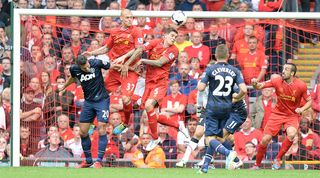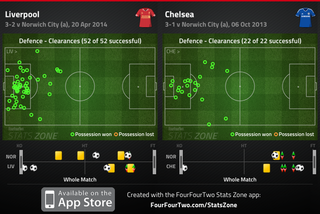How Liverpool's leaky back-line can be improved – and why it must be for next season
Michael Cox suggests how the Reds' forgiving rearguard can shape up in the last three games of the campaign...

There’s an old saying in football that goes something like this: strikers win you matches, but defenders win you titles. It’s backed up by statistical evidence, too – in The Numbers Game, a recent book about stats in football, it was shown that sides with the best defence win major league titles more frequently than the sides with the best attack.
Liverpool are about to prove that old saying wrong, however. Throughout this season, Liverpool’s main strength has been up front, with Luis Suarez and Daniel Sturridge first and second in the goalscoring charts, and their obvious weakness is at the back. Amazingly, 11 other sides in the division have a better record of keeping clean sheets – including the likes of Crystal Palace and Norwich City – and Liverpool are set to end the campaign with a leakier defence than any previous Premier League champion.
To a certain extent, this is two sides of the same coin: the more you attack, the more you leave your defence exposed. But this isn’t necessarily true based upon the way Liverpool have played, particularly over the past three months – their midfield has sat quite deep, and they’ve protected their back four intelligently. Steven Gerrard isn’t a natural holding midfielder but has played the role excellently, while Jordan Henderson’s energy has been crucial in the midfield zone and Coutinho has surprised many with the strength of his tackling. The full-backs, Glen Johnson and Jon Flanagan, have also enjoyed solid campaigns.

The problem, in truth, has been at centre-back and the resulting overall positioning of the side. Liverpool have suffered from a succession of injuries in the back four, but it’s still questionable whether Brendan Rodgers is sure of his best partnership. Mamadou Sakho has proved a fine signing, but his logical partner seems to be Daniel Agger, rather than Martin Skrtel, who Rodgers has preferred. The suspicion that Rodgers dislikes playing both Sakho and Agger, two left-sided centre-backs together, doesn’t entirely explain his selection decision.
Get FourFourTwo Newsletter
The best features, fun and footballing quizzes, straight to your inbox every week.
Agger and Skrtel are very different types of centre-backs, which is partly why they boasted such a good relationship together. Agger is a technical player capable of bringing the ball forward, while Skrtel is more basic, happier challenging in the air. To a certain extent, Skrtel suits Liverpool’s recent gameplan in big matches more. They’ve often conceded a lot of pressure and defended very deep, which means Skrtel’s penalty-box presence has been useful for making a succession of clearances. The last time Agger and Skrtel played together, in the 4-0 win over Tottenham, Skrtel dealt with more high balls in the penalty box:

It’s a chicken-and-egg situation, though, because Skrtel’s lack of pace means he forces Liverpool to defend deeper than usual, and this has caused goalkeeper Simon Mignolet problems. Although a fine shot-stopper, Mignolet never looks comfortable when coming for crosses – he was unfortunate to concede against West Ham when Andy Carroll clearly fouled him, but his error last weekend against Norwich had been on the cards for a while.
Liverpool basically defend a little too deep, and don’t withstand the pressure particularly well. This feels like a team which should be 10 yards higher up the pitch. A related issue is the fact neither Skrtel and Sakho move the defensive line up, a problem in terms of personality rather than pace. For example, towards the end of last season Jamie Carragher enjoyed an extended role in the centre of defence, and while he clearly wasn’t very fast, he understood the importance of not being pushed back too deep, and continually shouted at the defence to push up.
Even when compared to Chelsea, for example, Liverpool defend much deeper – see a comparison from their respective games away at Norwich:

The value of sitting deep, in the context of Liverpool’s campaign, is that it gives them more space to break into – and the sublime performances of Daniel Sturridge, Luis Suarez and Raheem Sterling in recent weeks have justified the overall approach.
Liverpool probably won’t be able to count on such prolific seasons from the SAS next year, however, and Rodgers might have to concentrate on keeping more clean sheets. If so, the return of Agger – or, more likely, the recruitment of a young centre-back capable of playing higher up – might be the best way for Liverpool to concede fewer goals.

Thank you for reading 5 articles this month* Join now for unlimited access
Enjoy your first month for just £1 / $1 / €1
*Read 5 free articles per month without a subscription

Join now for unlimited access
Try first month for just £1 / $1 / €1
